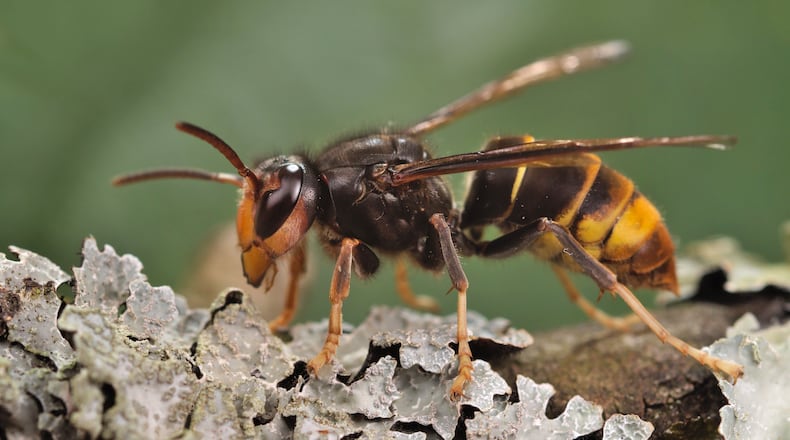A huge nest of bee-eating, yellow-legged hornets was found and destroyed late last week near the Georgia coast, and state officials are urging the public to stay on the lookout for more.
The nest of the hornets, known by the scientific name Vespa velutina, was discovered 85 feet up in a tree in a residential neighborhood near Savannah, officials of the Georgia Department of Agriculture (GDA) said. The discovery was not far from where the first two specimens were found by a beekeeper in early August.
On the night of August 23, a pest control company sprayed the nest with the insecticide cypermethrin to kill the adult hornets. Then, a tree surgeon cut the rest of the hive out of the tree, Agriculture Commissioner Tyler Harper said during a news conference last Friday.
Harper said GDA staff are confident that very few hornets escaped the nest alive. Any that did survive are sterile, female workers who are incapable of reproducing and only live for a few weeks, he added.
He praised his department and their partners at the University of Georgia and the U.S. Department of Agriculture for their help in the operation. He said they will continue monitoring the area until they’re able to confirm that this was the only colony. He urged beekeepers and members of the public to report any new potential sightings, too.
“We’re going to continue our efforts until we know for certain that the yellow-legged hornet is completely eradicated,” he said.
Credit: Danel Solabarrieta
Credit: Danel Solabarrieta
The nest was eliminated less than two weeks after the invasive species was initially discovered in Georgia, marking the first time the hornets had been found in the wild on U.S. soil.
Before the discovery of the nest, Harper said a total of four yellow-legged hornets had been spotted, all in the same general area near Savannah. No other specimens have been confirmed elsewhere in Georgia or in other states.
Yellow-legged hornets are native to southeast Asia. They are close relatives of the Northern giant hornet, also known as the “murder hornet,” another invasive species that turned up in Washington state in 2019.
They also resemble several other species already found in Georgia, but have distinctive yellow tips on the ends of their legs. It is the insects’ aggressive behavior toward honeybees, however, that really sets them apart from native species. Yellow-legged hornets are voracious predators that are known to dive-bomb honeybee hives to pickoff unsuspecting bees as they enter and exit, earning them the nickname the “bee hawk.”
Their nests are also much larger than those constructed by other Georgia insects, said Will Hudson, an entomology professor at UGA. Nests of bald-faced hornets, a species commonly found in Georgia, typically house 500 to 600 individuals. The massive, tan nests that yellow-legged hornets construct can hold 10 times that many.
Globally, bees and pollinators have already faced steep declines in recent decades because of parasites, climate change, pesticide use and other human activity. If the hornet is able to gain a foothold in Georgia, experts have warned it could have a devastating impact on pollinators and in turn, the state’s agriculture industry.
All told, Georgia’s pollinator-dependent crops are worth an estimated $430 million annually, UGA experts have said. Blueberries, watermelons, cantaloupes, squashes and cucumbers all rank among Georgia’s most valuable food crops, and all rely on honeybees and other pollinators to ensure bountiful harvests.
What to do if you spot a yellow-legged hornet
- Report possible sightings to the Georgia Department of Agriculture via their online form available at https://agr.georgia.gov/yellow-legged-hornet.
- Take a photograph at a safe distance, if possible.
- Check to ensure the insect is indeed a yellow-legged hornet. A photo gallery of native pollinators and lookalikes can be accessed at www.aphis.usda.gov by searching for “yellow-legged hornet.”
- Send questions or comments to yellow.legged.hornet@agr.georgia.gov
A note of disclosure
This coverage is supported by a partnership with 1Earth Fund, the Kendeda Fund and Journalism Funding Partners. You can learn more and support our climate reporting by donating at ajc.com/donate/climate/
About the Author
Keep Reading
The Latest
Featured


